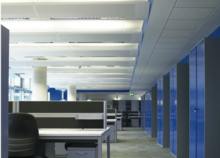Ceiling rafts enable slab to interact thermally with building interior

Not only do these SAS lighting rafts installed in a building in Lewisham integrate a range of services, but they also enable the thermal mass of the slab to be exploited.
SAS International’s System 600 acoustic lighting rafts are at the heart of the building-services strategy for the £13.3 million Kaleidoscope centre of children and young people in Lewisham. They were specified by Max Fordham Consulting Engineers and are used with HCP radiant heating panels. These panels are directly suspended from the structural soffit and allow free air movement to the structural slab for natural-mass cooling. Radiant heating and cooling was preferred for its compatibility with the cooling system embedded in the slab. This approach avoided the need for radiators at low level, which would use valuable floor space, constrain room layouts and be a potential hazard for children. The curved-profile System 600 modules were installed on all five floors of the building, in consulting rooms, in individual offices and open-plan spaces. The modules house both single and dual central luminaires, fire-alarm detectors and daylight sensors linked to lighting controllers. HCP, a division of SAS, supplied and installed the radiant heating and cooling panels around the perimeter of the glass curtain to help offset fabric and ventilation heat losses in winter and heat gains in summer. The panels were recessed to sit flush with the ceiling soffit and have perforations on the underside. 515 linear metres have been installed.
Related links:


